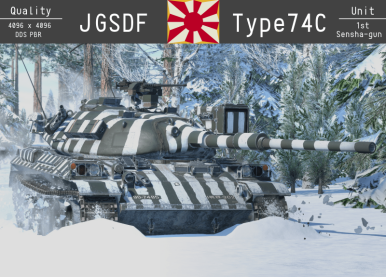



The Type 74 (C) (74式戦車C型) is among the earliest production variants of the Type 74, featuring the early ammunition set for the 105 mm L7A3 cannon. It was built up as the production model for Japan's 2nd generation of MBTs to combat tanks such as the T-62 and compare to the M60 or Leopard 1, while supplementing and replacing the Type 61. While a feature-full tank with hydropneumatic suspension and an effective 105 mm L7A3 cannon, it was a pretty late Gen 2 entry, as the 3rd generation of MBTs (such as the Leopard 2 and M1 Abrams) would enter service just a few years later.
The most distinctive difference between the Type 74 (C) and the subsequent Type 74 (E) is the lack of a thermal shroud around the 105 mm L7A3 cannon (this feature was introduced in the Type 74 (D) variant).
It was introduced in Update "Direct Hit". As the earliest of the Type 74s, and has only APDS, HEAT and HESH ammunition. It does not have the APFSDS rounds that the later versions have. It has average mobility and a hydropneumatic suspension system that allows it to adjust its height and angle according to the terrain. It also has a laser rangefinder and a warning system that make it effective as a sniper.
| Ammunition | Type | Armor penetration (mm) at a distance: | |||||
|---|---|---|---|---|---|---|---|
| 10 m | 100 m | 500 m | 1000 m | 1500 m | 2000 m | ||
| APDS | 350 | 347 | 333 | 317 | 302 | 287 | |
| HESH | 127 | 127 | 127 | 127 | 127 | 127 | |
| HEATFS | 400 | 400 | 400 | 400 | 400 | 400 | |
| Belt | Belt filling | Armor penetration (mm) at a distance: | |||||
|---|---|---|---|---|---|---|---|
| 10 m | 100 m | 500 m | 1000 m | 1500 m | 2000 m | ||
| API-T/I/AP/API-T | 31 | 29 | 21 | 14 | 9 | 6 | |
| Belt | Belt filling | Armor penetration (mm) at a distance: | |||||
|---|---|---|---|---|---|---|---|
| 10 m | 100 m | 500 m | 1000 m | 1500 m | 2000 m | ||
| AP/AP/T | 13 | 12 | 7 | 3 | 2 | 0 | |












Mobility | |
|---|---|
Protection |
|---|
Firepower | ||
|---|---|---|
